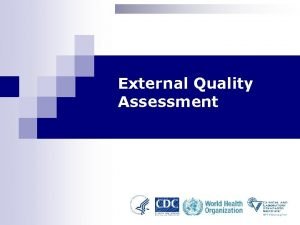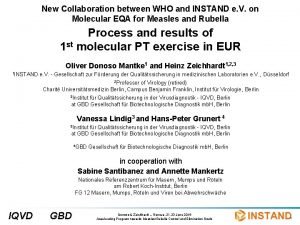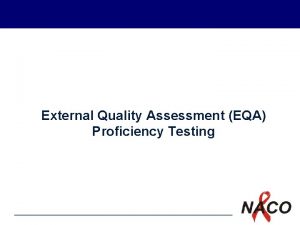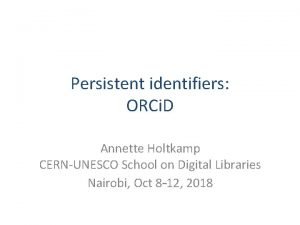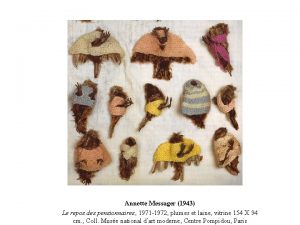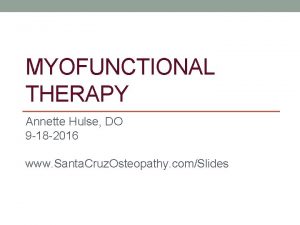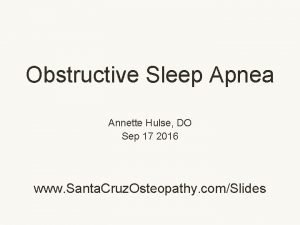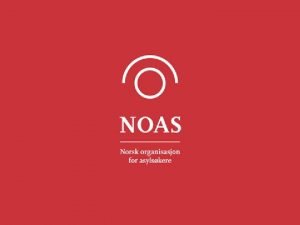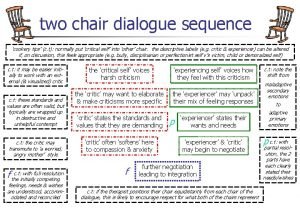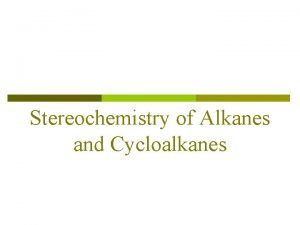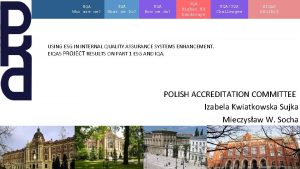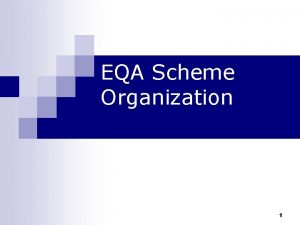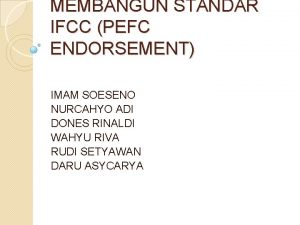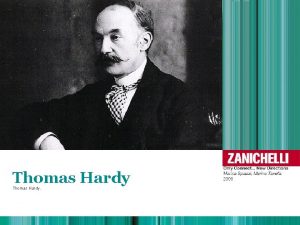1 Principles of EQA Annette Thomas Chair IFCC
















































![49 [1] Are you satisfied with your imprecision values? (Sy. x, r) NO [3] 49 [1] Are you satisfied with your imprecision values? (Sy. x, r) NO [3]](https://slidetodoc.com/presentation_image_h/0a59aaa1ea6d9c65233ab23cafbf3e0d/image-49.jpg)






- Slides: 55

1 Principles of EQA Annette Thomas Chair IFCC C-AQ Director Weqas www. weqas. com Advancing excellence in laboratory medicine for better healthcare worldwide

What is External Quality Assessment? = proficiency testing scheme System designed to objectively assess the quality of results by an external agency. Advancing excellence in laboratory medicine for better healthcare worldwide 2

IQC vs EQA Internal Quality Control Results 3 External Quality Assurance Known Unknown Immediately Later, when report received Minimum daily, per batch, per shift Periodically eg monthly/ Bimonthly quarterly Normal, abnormal Pathological range covered over multiple samples Assess Imprecision Accuracy & imprecision Comparison Your lab only Your lab to all labs & other labs using your method Results Available Frequency of Testing Concentrations Advancing excellence in laboratory medicine for better healthcare worldwide

Types of EQA Schemes – which one for you ? PT, EQA or EQAP? Scope Accredited to ISO 17043 • Commercial • Not for profit • Linked to professional body • Regulatory • Broad Scope - All disciplines • Narrow Scope - Discipline specific • Limited scope – Specialist • Yes • No? Advancing excellence in laboratory medicine for better healthcare worldwide 4

Expectations of EQA Provider Accreditation status – 17043 Clinically relevant Distribution frequency • If not accredited, labs should justify why • Variable across Schemes (EQALM study 2009) * • Where EQA used to assess IVDs, minimum of 6 distributions p. a. (BS EN 14136: 2004) • For core tests - monthly Clinically relevant Range and number of samples • Evidence of reproducibility • Cover clinically appropriate range • “Blinded” • Commutable materials • Challenging samples Clinically relevant performance criteria • Based on clinical outcomes • Based on biological variation * A Thomas, Accred Qual Assur (2009) 14: 439 -444 Advancing excellence in laboratory medicine worldwide * A Thomas, Accred for Qualbetter Assurhealthcare (2009) 14: 439 -444 Scheme designed and overseen by appropriately competent professionals • Clinical Scientist or medically qualified • Independent Scientific or Medical Advisory group. • Statistical expertise Reporting to • Mechanism for identification and Professional body reporting of Persistent Poor / Regulatory body. performance issues Education Post-marketing surveillance • Training • Helpline • Pre analytical • Post Analytical • Alerts manufacturers • Alerts competent authority • Alerts laboratories • Alerts professional bodies 5

Objectives of EQA 6 Provide a measure of the quality of a test To supplement internal quality control procedures Provide a measure of the “state of the art” of a test To obtain consensus values when true values are unknown To investigate factors in performance (methods, staff etc) To act as an educational stimulus to improvement in performance • To provide a Post market vigilance service • To provide evidence and monitoring of harmonisation strategies • • • IFCC 1977 Advancing excellence in laboratory medicine for better healthcare worldwide

General Cycle of EQAS EQA samples received Corrective action taken if required User analyses EQA samples EQA report reviewed Results sent to EQA organiser EQA report received Advancing excellence in laboratory medicine for better healthcare worldwide 7

Choosing an EQA - considerations üDesign for clinical need üMaterial type & frequency Identify performance specification Data analysis Reports Education element Troubleshooting support Advancing excellence in laboratory medicine for better healthcare worldwide 8

Material & Frequency • • • Appropriate matrix Stable, homogeneous material Appropriate concentration range Challenging samples Appropriate frequency of testing Advancing excellence in laboratory medicine for better healthcare worldwide 9

Sample Matrix Lyophilized material – serum / urine / whole blood – – Pro Good long term stability Very easy to transport – – – Advancing excellence in laboratory medicine for better healthcare worldwide Con Commutability issues Expensive Difficult to prepare reconstitution errors Denaturation of proteins/lipoproteins Issues with assigning reference targets 10

Sample Matrix 11 Fresh/ Frozen clinical material - from individual donors or pool of donors Pro – Gold standard – Commutable – performs as patient samples – Easy to use – Can set reference targets – – Advancing excellence in laboratory medicine for better healthcare worldwide Con Difficult to obtain different concentration levels Unstable analytes Storing and transport expensive Risk of bacterial contamination

Appropriate Concentration Levels • • • Clinically relevant Range of concentration levels Not just around the reference interval Cover the analytical and pathological range Challenging samples Advancing excellence in laboratory medicine for better healthcare worldwide 12

Choosing an EQA? üDesign for clinical need üMaterial type & frequency üIdentify performance specification Data analysis Reports Education element Troubleshooting support Advancing excellence in laboratory medicine for better healthcare worldwide 13

What is the Target Value? • Determining the ‘right’ , ‘true’, ‘correct’ value? Advancing excellence in laboratory medicine for better healthcare worldwide 14

Target Value • Reference value – “True” value with meteorological traceability. – Commutable EQA material assayed using: – Reference methods eg Hb. A 1 c – By an Accredited reference laboratory • Using higher order methods eg IDGC-MS glucose, creatinine. • Certified Reference material Advancing excellence in laboratory medicine for better healthcare worldwide 15

Advantage of Reference Measurement Targets • Traceable to higher order • Establishes method traceability for the lab– requirement of ISO 15189 • Independent assessment of manufacturer traceability claims. • Highlights the pitfalls of using the trimmed overall mean as an accuracy target in EQA Schemes • Overall mean and method mean may not be traceable, may not be stable, may be influenced by large numbers from one manufacturer. • Useful in the post market vigilance of the IVD Directive Advancing excellence in laboratory medicine for better healthcare worldwide 16

Traceability • Reference measurement values shown on report (and reference value uncertainty). Full traceability chain to SI units available. • Lab results compared directly to reference values • SDI scores, Sigma scores and bias plot based on reference values Advancing excellence in laboratory medicine for better healthcare worldwide 17

Use of gravimetric data Analyte Gravimetric LC-MS/MS Recovery % Amphetamine (ug/L) 3000 2936 97. 9 Cannabis (ug/L) 300 227 75. 7 Opiate (Morphine) (ug/L) 5000 5483 109. 7 Benzodiazepine (ug/L) 800 749 93. 6 Cocaine (ug/L) 800 842 105. 3 Methadone (EDDP) (ug/L) 600 720 120. 0 Methamphetamine (ug/L) 3000 3193 106. 4 6 -Acetylmorphine (ug/L) 30 25 83. 3 Buprenorphine (ug/L) 30 31 103. 3 Ketamine (ug/L) 3000 2786 92. 9 Barbiturates (ug/L) 800 820 102. 5 MDMA (ug/L) 2500 2766 110. 6 Phencyclidine (ug/L) 73. 4 78* 106. 3 Advancing excellence in laboratory medicine for better healthcare worldwide 18 Traceability Good agreement was observed between the ‘gravimetric’ weighed in target and the LCMS/MS data for the majority of analytes, however a decreased recovery of 76% and 83% was observed for cannabis and acetylmorphine respectively.

Target Value 19 • Statistical – Overall mean, median – Method, instrument mean – Shows the ‘state of art’ of method performance but gives no indication of the “true” value Advancing excellence in laboratory medicine for better healthcare worldwide

Using Statistical Comparison 20 • Mean ± 2 SD = 95% returned results are acceptable • This gives information on whether your result is acceptable compared with all results and your method • But does it give information on whether your result is acceptable compared to the ‘true’ patient result? • Would your result alter the clinical management of the patient? • Does not provide context to clinical utility Advancing excellence in laboratory medicine for better healthcare worldwide

External Quality Assurance Programs 21 • Use quality standards to allow labs to assess their performance and respond accordingly • the quality standard is the allowable difference from a target • A tool for review of QAP results • Can be based on – statistical comparison – expert opinion – clinical need – other criteria Advancing excellence in laboratory medicine for better healthcare worldwide

Target values used in Quantitative EQA Loss of information for Assessment of accuracy Reference values Gold standard Gravimetric Overall mean / median Method mean / median Used if no ref and data Gaussian. Peer group assessment only Advancing excellence in laboratory medicine for better healthcare worldwide Analyser mean Peer group assessment only. 22

What is the best approach? 23 • Fresh Patient / commutable samples using reference method as target • Fresh patient / commutable samples using a secondary reference method as target • Fresh patient / commutable samples using data from peer group of expert laboratories as target • Mean / median of method group with acceptable performance using fresh patient / commutable samples • Commercial material. - It is essential to understand how the matrix affects the performance of methods if non commutable material is used. Only peer review within instrument / method group can be undertaken in these instances. Advancing excellence in laboratory medicine for better healthcare worldwide

24 Determining Performance specifications. Advancing excellence in laboratory medicine for better healthcare worldwide

Acceptable Performance Specification 25 • A range of values around the target value that is considered acceptable laboratory performance • A tool for review of EQA results • It provides a simple tool to allow a rapid, standardised assessment of EQA results in both numerical and graphical report formats. • A result outside the acceptable range should alert the laboratory that their assay may produce results that are at risk of detrimentally affecting clinical decision making. Advancing excellence in laboratory medicine for better healthcare worldwide

Using Statistical Comparison Method 1 TEe = 10% Method 2 TEa = 5% • Mean ± 2 SD = 95% returned results are acceptable • This gives information on whether your result is acceptable compared with all results and your method • May not be clinically relevant Advancing excellence in laboratory medicine for better healthcare worldwide 26

Which Performance Criteria to use? Regulatory requirement, TE Acceptable performance from EQA, TE % Test CLIA (US) Rilibak RCPA (Germany) (Aus) Glucose ± 0. 33 ± 15% mmol/l or ± 10% ± 0. 5 ± 7. 5%@4 mmol/l or mmol/l ± 10% Hb. A 1 c n/a ± 0. 5 or ± 5% ± 18% Advancing excellence in laboratory medicine for better healthcare worldwide WEQAS (UK) ± 7% Labquality (Finland) ± 6. 0% 27

Specification Hierarchy Model 1 Analytical performance specification based on clinical outcomes • What we need but data not readily available Model 2 Analytical performance specification based on biological variation • Data from available but not outcome studies always achievable Advancing excellence in laboratory medicine for better healthcare worldwide 28 Model 3 “State of the art” Interlaboratory variation • What we can achieve but may not be “fit for Improvements in purpose” methods / technology

From Biological goals Test I (%) B (%) TE (%) (0. 01) Glucose 2. 2 1. 9 7. 0 Hb. A 1 c 1. 7 1. 5 5. 5 Desirable quality specification can be calculated from: I < 0. 5 CVw B< 0. 25 (CVw 2 + CVb 2)½ TE = 2. 33 I + B (a<0. 01) for EQA Advancing excellence in laboratory medicine for better healthcare worldwide 29

Analytical goals 30 Biological goals Weqas TE criteria Analyte Conc. I (%) B (%) TE (0. 01) SD 2 SD TE Albumin 40 1. 6 1. 3 4. 9 1. 3 2. 6 6. 5 Bicarb 20 2. 4 1. 6 7. 2 1. 3 2. 6 13. 0 Ca 2. 3 1 0. 8 3. 1 0. 05 0. 1 4. 3 Cl 100 0. 6 0. 5 1. 9 1. 4 2. 8 Creat 80 2. 2 3. 4 8 16 20. 0 Glucose 4. 2 2. 2 1. 9 7. 0 0. 16 0. 32 7. 6 Mg 0. 8 1. 8 6. 0 0. 03 0. 06 7. 5 Osmo 245 0. 7 0. 4 2. 0 3. 4 6. 8 2. 8 Phos 0. 8 4. 3 3. 2 13. 1 0. 03 0. 06 7. 5 K 4 2. 4 1. 8 7. 4 0. 08 0. 16 4. 0 Na 135 0. 4 0. 3 1. 2 1. 5 3 2. 2 T P 70 1. 4 1. 2 4. 4 1. 6 3. 2 4. 6 Urate 0. 34 4. 3 4. 8 14. 8 0. 02 0. 04 11. 8 Urea 8 6. 2 5. 5 19. 8 0. 35 0. 7 8. 8 Advancing excellence in laboratory medicine for better healthcare worldwide Highlighted TE are those where Biological goals not achievable

Creatinine Precision Profile (CV %) 45. 00 31 40. 00 35. 00 1999 -2000 30. 00 2004 -2010 cv 25. 00 2011 20. 00 2012 15. 00 10. 00 Biological Goal Te = 8. 4 % 5. 00 0 100 200 300 400 500 Overall Mean Creatinine (umol/L) Advancing excellence in laboratory medicine for better healthcare worldwide 600 700

Choosing an EQA - considerations üDesign for clinical need üMaterial type & frequency üIdentify performance specification üData analysis üReports Education element Troubleshooting support Advancing excellence in laboratory medicine for better healthcare worldwide 32

What to Look for in the EQA Reports • Design should be such that the user can: – Understand the report – take appropriate action – provide help and improvement – Is education Advancing excellence in laboratory medicine for better healthcare worldwide 33

What to Look for in EQA Reports? 34 • What is the turn around time? – how long after the due date will you receive your report? – the earlier the better – can remember what was happening at that time – can take corrective action sooner • Is the report electronic or paper? – Electronic quicker but not all sites may have printer access. Advancing excellence in laboratory medicine for better healthcare worldwide

What to Look for in EQA Reports? • Report should – Clearly identify performance • • • Assess accuracy to target value Assess imprecision Assess linearity Assess performance over time Identify errors and poor performance – Clearly identify method / analyser performance Advancing excellence in laboratory medicine for better healthcare worldwide 35

Assessment of Accuracy • From the linear regression analysis equation, y=mx+c, the trueness (bias) is calculated at the critical level (x) , which for Cholesterol is 5. 0 mmol/L. • when x=5 then y= 0. 9777(*5)+0. 042 = 4. 9305 • Bias = (y-x)/x*100 = (4. 9305 -5. 0)/5. 0*100 = -1. 39% • Imprecision (CV) = Sy. x/ x = 0. 026/5. 0*100 = 0. 5% Advancing excellence in laboratory medicine for better healthcare worldwide 36

Uncertainty From EQA Data • Laboratory within run Imprecision: • Sy. x = 0. 06 mmol/L • CV% = (Sy. x/ x)*100 = 0. 06/7*100 = 0. 86% Advancing excellence in laboratory medicine for better healthcare worldwide 37

Uncertainty From EQA Data • • • Between batch CV% provided on End of Batch reports (12 month review) Pool M 891 a - CV% of reported results: 4. 51% Top-down approach – CV% is method uncertainty (relative standard uncertainty) Advancing excellence in laboratory medicine for better healthcare worldwide 38

Specificity and Sensitivity Studies Pregnancy testing Advancing excellence in laboratory medicine for better healthcare worldwide Bile Acids 39

Post Market vigilance – INR thromboplastin INR results classified into pre and post recalibration. 40 participants using strips calibrated to WHO reference thromboplastin r. TF/09 The pre calibration strips compared well with the results from Distribution 0517 (Median 2. 8) however much higher results and a wider distribution of results was observed for the post calibration strips. Weqas immediately contacted the manufacturer and sent them the data. Aug 2018 – Urgent field safety notice issued to inform users that the manufacturer was reverting back to previous WHO reference standard. Advancing excellence in laboratory medicine for better healthcare worldwide

Choosing an EQA - considerations üDesign for clinical need üMaterial type & frequency üIdentify performance specification üData analysis üReports üEducation element Troubleshooting support Advancing excellence in laboratory medicine for better healthcare worldwide 41

Educational role • Pre-analytical effects • Number and type of methods used • Performance of methods used • accuracy • precision • Susceptibility of methods to interference • including other analytes and matrix • Interpretation of results Advancing excellence in laboratory medicine for better healthcare worldwide 42

Educational role • Education on methods and interferences • eg – Concentration near diagnostic “cut off” – Samples with known variants for Hb. A 1 c – Samples with added interferances Advancing excellence in laboratory medicine for better healthcare worldwide 43

Intralaboratory variation – Roche Tn. T 44 30 25 AF Lo. Q 20 AJ CV % AQ 1 AQ 2 15 AH 1 AH 2 AI 1 10 AI 2 JU 1 ULN 5 JU 2 0 0 2 4 6 8 10 Troponin T (ng/L) Advancing excellence in laboratory medicine for better healthcare worldwide 12 14 16 18 20

Interferences - Effect of icterus on assays Advancing excellence in laboratory medicine for better healthcare worldwide 45

Choosing an EQA - considerations üDesign for clinical need üMaterial type & frequency üIdentify performance specification üData analysis üReports üEducation element üTroubleshooting support Advancing excellence in laboratory medicine for better healthcare worldwide 46

Troubleshooting Support • Can they provide a consultation service? • Available by phone, fax, e-mail • Provide help with – method classification queries – analyte problems – report interpretation – troubleshooting Advancing excellence in laboratory medicine for better healthcare worldwide 47

Problem Solving Flow Chart Advancing excellence in laboratory medicine for better healthcare worldwide Pages 18 -19 of SP-QL 1 -Int. Lab. EQA 48
![49 1 Are you satisfied with your imprecision values Sy x r NO 3 49 [1] Are you satisfied with your imprecision values? (Sy. x, r) NO [3]](https://slidetodoc.com/presentation_image_h/0a59aaa1ea6d9c65233ab23cafbf3e0d/image-49.jpg)
49 [1] Are you satisfied with your imprecision values? (Sy. x, r) NO [3] Check whether the cause is curvilinear data (m, c, Sy. x, r) Problem Solving Flow Chart NO [4] Then the error is random, check whethere is clerical error. YES IMPRECISION NO [5] Check for causes of imprecision e. g. inexperienced operators, faulty equipment, inappropriate methods Eliminate blunder go to [2] Advancing excellence in laboratory medicine for better healthcare worldwide Pages 18 -19 of SP-QL 1 -Int. Lab. EQA

Problem Solving Flow Chart Advancing excellence in laboratory medicine for better healthcare worldwide Pages 18 -19 of SP-QL 1 -Int. Lab. EQA 50

Problem Solving Flow Chart Curvilinear (m, c, Sy. x, r) proportional (m) Check for time expired reagents NO NO YES Check all Calibrators Replace inc. zero reagents INACCURACY 51 mixed (m, c) constant (c) Is it a “one point” cal? YES Recalibrate (try different lot) Are you satisfied with slope (m)? YES Run linearity check Are you satisfied with intercept (c)? NO Check slope value of instrument Advancing excellence in laboratory medicine for better healthcare worldwide Pages 18 -19 of SP-QL 1 -Int. Lab. EQA Check zero (reagent blank, serum blank, instrument zero). NO Adjust & Recalibrate Check method specificity YES

EQA and User in partnership Part of Quality Improvemen t • Should not be viewed as a pass/fail exercise • Educational – troubleshooting, recommendations of best practice • Identify poor methods • Provide training and help Advancing excellence in laboratory medicine for better healthcare worldwide 52

Key elements of National EQA Laboratory Manufac turer EQA Provider Competent Authority Professional / Regulatory body Method performance evaluation Post market vigilance Participant Performance evaluation Quality improvement Continuous Education Harmonisation of results Harmonisation of processes Audit and recommendations Advancing excellence in laboratory medicine for better healthcare worldwide 53

54 Advancing excellence in laboratory medicine for better healthcare worldwide

55 Advancing excellence in laboratory medicine for better healthcare worldwide
 Annette thomas
Annette thomas Types of eqa
Types of eqa Iqvd
Iqvd Dermatopathology eqa
Dermatopathology eqa What is eqa
What is eqa Pathologist and anthropologist
Pathologist and anthropologist Annette redmond
Annette redmond Annette hjort olsen
Annette hjort olsen Annette westin
Annette westin Annette toledo
Annette toledo Christophine wide sargasso sea
Christophine wide sargasso sea Aph emserberg
Aph emserberg Annette downey
Annette downey Lena merkle
Lena merkle Annette holtkamp
Annette holtkamp Annette strauch
Annette strauch Les pensionnaires annette messager
Les pensionnaires annette messager Annette freibauer
Annette freibauer Annette pol
Annette pol Annette hulse
Annette hulse Annette lucien
Annette lucien Imap logineo nrw
Imap logineo nrw Annette brinkman
Annette brinkman Digi notar
Digi notar Annette rinke
Annette rinke Annette babakhanian
Annette babakhanian Annette hulse
Annette hulse Annette thommessen
Annette thommessen Annette holder
Annette holder Annette brinkman
Annette brinkman Annette groot
Annette groot Annette søndergaard gregersen
Annette søndergaard gregersen Annette cowie
Annette cowie Annette demers
Annette demers Guggenmos löwenzahn
Guggenmos löwenzahn Mary shelley marido
Mary shelley marido Annette weidmann
Annette weidmann Annette schermer
Annette schermer Annette heller
Annette heller Annette buchanan
Annette buchanan Annette demers
Annette demers Heterotop ossifikasjon
Heterotop ossifikasjon Across the wide sargasso sea
Across the wide sargasso sea Annette gregg
Annette gregg Annette haberl
Annette haberl S-curve silhouette
S-curve silhouette Is this a pencil?
Is this a pencil? Two chair dialogue
Two chair dialogue Barany chair
Barany chair Bond angle in cyclohexane
Bond angle in cyclohexane Moon rhyming words with meaning
Moon rhyming words with meaning Red white and blue chair
Red white and blue chair One point perspective living room drawing
One point perspective living room drawing Chair hazard
Chair hazard Fdinde
Fdinde Design on cup
Design on cup

